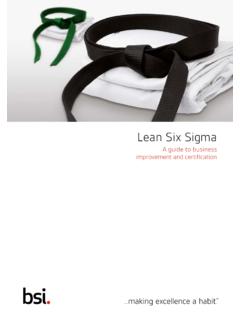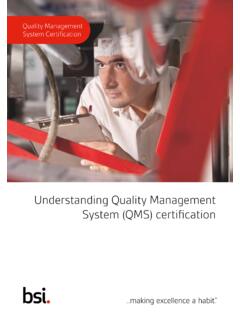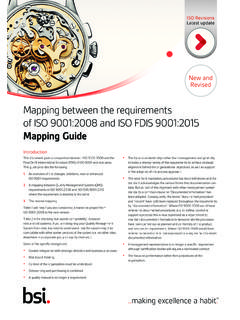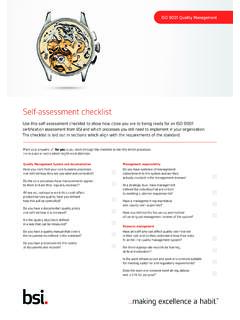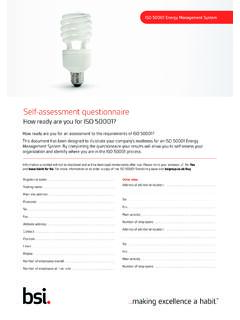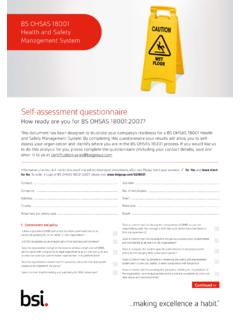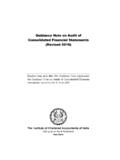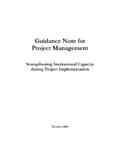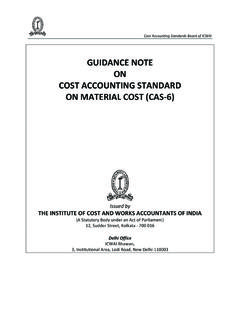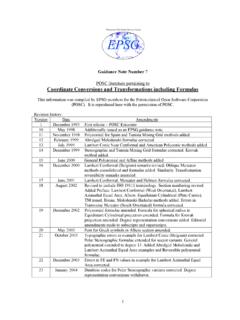Transcription of Guidance Note on the - BSI Group
1 Guidance Note on the Construction Products RegulationVersion 1 - April 2012 TECHNICALAPPROVALSFORCONSTRUCTIONAPPROVA LINSPECTIONTESTINGCERTIFICATIONG uidance Note on the Construction Products RegulationVersion 1 - April 2012 This Guidance Note is to be regarded as a live document which will be updated periodically when additional information clarifying any points becomes available. 1 Guidance Note on the Construction Products Regulations - Version of this guide and concepts of the technical marking under the of and verification of constancy of of CE Manufacturers and other economic operators8- Importers and distributors8- Regulations/regulators9- Public bodies9- Designers/Contractors10- Insurers10- Product Contact Points for providers10- Notified bodies10- Technical Assessment Bodies (TAB)11- Further issues11- CE marking on the basis of an hEN11- CE marking on the basis of a European Technical information12 Appendix ATerminology13 Appendix BExample Declaration of Performance15 Appendix CAssessment of conformity tasks17 CONTENTS1.
2 Purpose of this guide and The construction industry is facing the most significant change for a decade in the way in which construction products are sold in Europe. From 1 July 2013, under the Construction Products Regulation 20111 (CPR), it will become mandatory for manufacturers to apply CE marking to any of their products which are covered by a harmonised European standard (hEN) or European Technical Assessment (ETA). This is a major change as affixing of CE marking under the provisions of the existing Construction Products Directive (CPD) is currently voluntary in the UK. For those already CE marking under the CPD the transition should be straightforward. This publication is intended as a guide to the implications of CE marking under the CPR for manufacturers, importers, distributors, specifiers, certification and test bodies, and regulatory/enforcement authorities. The Regulation is directly applicable in UK law and neither this guide nor its authors purport to offer any definitive legal This Guidance note has been prepared by the Construction Products Association (CPA), the British Board of Agr ment (BBA), British Standards Institution (BSI) and FBE Management Limited in consultation with the Trading Standards Institute (TSI).
3 2. Key concepts of the The CPR builds upon the CPD and aims to break down technical barriers to trade in construction products within the European Economic Area (EEA). To achieve this, the CPR provides for four main elements: a system of harmonised technical specifications an agreed system of conformity assessment for each product family a framework of notified bodies CE marking of The CPR harmonises the methods of assessment and test, the means of declaration of product performance and the system of conformity assessment of construction products, but NOT national building regulations. The choice of required values for the particular intended use is left to the regulators and public / private sector procurers at the national level. However, such required values must be expressed in a consistent manner (technical language) as used in the harmonised technical Some elements of the CPR came into force on 24 April 2011. The first changes apply to notified bodies and technical approval bodies and the way in which they operate.
4 The full legislation relating to manufacturers, importers and distributors comes into force on 1 July 2013, when the CPD will be Appendix A contains a guide to some of the terminology. 1 The CPR can be found at :L:2011:088:0005:0043:EN:PDFG uidance Note on the Construction Products Regulations - Version 12 CONTENTS3. Harmonised technical Under the CPR, harmonised technical specifications are harmonised European product standards (hENs) established by CEN/CENELEC2 or European Assessment Documents (EADs) produced by the European Organisation for Technical Approvals (EOTA) as the basis for issuing ETAs for products not covered by hENs. The harmonised technical specification for a product defines EEA-wide methods of assessing and declaring all the performance characteristics required by regulations in any Member State which affect the ability of construction products to meet seven basic requirements for construction works. These cover :1.
5 Mechanical resistance and stability2. Safety in case of fire3. Hygiene, health and environment 4. Safety and accessibility in use5. Protection against noise6. Energy economy and heat retention7. Sustainable use of natural The main route to a harmonised technical specification under the CPR is for hENs to be drawn up and published by CEN/CENELEC. However, if hENs cannot be produced or foreseen within a reasonable period of time, or if a product deviates from the scope of a hEN, an ETA may be issued on the basis of an European product standards also address characteristics not regulated in any Member State, but which have been included for commercial reasons aesthetic characteristics. Because of this, all hENs under the CPR include an Informative Annex (termed Annex ZA), the first part of which ( ) lists the regulated requirements according to a mandate issued to CEN or CENELEC by the European Commission and the clauses in the standard in which they are addressed.
6 Some of these clauses may in turn refer to separate supporting documents such as test standards. In this way, Annex in the hEN becomes a checklist for CE marking from which the manufacturer can see all the mandatory requirements for their product and how they can be The parts of the standard which are not required to fulfil the mandate are termed the voluntary or non-harmonised parts. These are not included in, nor relevant to, Annex EADs will have a section serving the same function as Annex in a CE marking under the CE marking enables a product to be placed legally on the market in any Member State. However, as explained below, this does not necessarily mean that the product will be suitable for all end uses in all Member CE marking indicates that a product is consistent with its Declaration of Performance (DoP) as made by the manufacturer. The declaration varies according to the particular harmonised technical specification covering the product.
7 In general there are three ways in which information can be presented for each relevant characteristic: confirmation of achievement of a minimum performance or threshold. This could be by satisfying a Pass/Fail criterion or simply by being eligible to be in the standard. 2 CEN (Comit Europ en de Normalisation) provides a platform for the development of European Standards (ENs). CENELEC (Comit Europ en de Normalisation lectrotechnique) is the European Committee responsible for European Standardisation in the area of electrical Note on the Construction Products Regulations - Version 1 CONTENTS the actual performance (a declared value) a particular class of performance reached. As such, decision makers ( designers and specifiers) should understand the relevant performance requirements for the How CE marking is approached for a specific product is set out in the harmonised technical specifications. For hENs this is set out in Annex and for ETAs in a section in the Declarations of By making a DoP the manufacturer, importer or distributor is assuming legal responsibility for the conformity of the construction product with its declared performance.
8 The information to be contained in them is detailed in Annex ZA of a hEN or in a section of the EAD. DoPs must be publicly An example of a completed DoP for vertical air/flue terminals is given in Appendix Where minimum or maximum values have been set in the technical specifications, these need not be repeated in the DoP. Classes of performance may be declared within the DoP, with the key to the classes appearing in the technical specification. A detailed knowledge of the technical specification is therefore often Where a parameter is covered in the hEN or ETA, it is not permissible to quote any results obtained for that parameter using a different test method or different Together with the technical specification, the DoP should give all the information needed by specifiers and regulators to judge whether the product meets all relevant regulations in the Member State upon whose market it is to be placed. Provided that the manufacturer has met the requirements of at least one characteristic in the declaration of performance they are not required to determine and/or declare values relating to characteristics for which regulations do not exist in the chosen market sector ( Member state/intended use).
9 In these cases, a declaration of no performance determined (NPD) may be made, as provided for in the Where applicable, the declaration of performance should be accompanied by information on the content of hazardous substances in the construction product to improve the possibilities for sustainable construction and to facilitate the development of environment-friendly products. This is complicated by the fact that, for many substances, the necessary test methods have yet to be agreed. Initially it should be limited to substances referred under the Registration, Evaluation, Authorisation and Restriction of Chemicals (REACH). Guidance Note on the Construction Products Regulations - Version 14 CONTENTS6. Assessment and verification of constancy of The system of Assessment and Verification of Constancy of Performance3 (AVCP) is the term applied to define the degree of involvement of third parties in assessing the conformity of the product according to the relevant technical specification(s).
10 For each product family, the system of AVCP is decided collectively by the Member States and the European Commission. They do so on the basis of the implications of the product on health and safety and on the particular nature and production process for the product itself. To achieve this the CPR uses five main elements: Factory production control (fpc) on the basis of documented, permanent and internal control of production in a factory, in accordance with the relevant harmonised technical specifications Initial inspection of the manufacturing plant and of fpc Continuous surveillance, assessment and evaluation of fpc Determination of product type on the basis of type testing, type calculation, tabulated values or descriptive documentation of the product Audit testing of samples taken before placing the product on the The five systems of AVCP and the level of involvement of notified bodies in each is as follows:System 1+ product certification comprising the issuing of a certificate of constancy of performance with determination of the product-type, continuous surveillance and audit testing by a notified product certification body System 1 product certification comprising the issuing of a constancy of performance with determination of the product-type and continuous surveillance by a notified product certification bodySystem 2+ factory production control certification with continuous surveillance by a notified factory production control certification bodySystem 3 determination of product type by a notified testing laboratorySystem 4 manufacturer s tasks The tasks for the manufacturer and for any notified body for each system are summarised in Appendix For all systems the manufacturer is required to have a fully documented fpc system.
